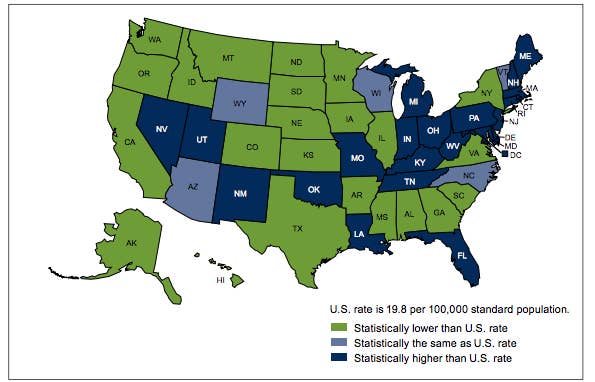
US life expectancy dropped for a second straight year in 2016, to 78.6 years, federal health officials reported on Thursday. The decline — down from 78.7 years in 2015 and 78.9 in 2014 — was driven by a large increase in fatal drug overdoses.
Heart disease and cancer are still the leading killers of Americans, but the 21% increase in fatal overdoses that killed 63,600 people last year moved “unintentional injuries” into third place as a cause of death nationwide. Those overdose deaths, largely among younger and middle-aged adults, dropped life expectancy for two consecutive years in the US — a pattern that hasn’t happened since 1963.
The drop underscores the severity of the overdose crisis, public health experts said, which was recently declared a national public health emergency by President Trump.
“The drugs that people are taking now are more deadly,” health economist Richard Frank of Harvard Medical School told BuzzFeed News. Together with heroin itself, illicit fentanyl and other synthetic opioid drugs now tainting street drugs are responsible for more than half of all overdose deaths, taking over from misuse of prescription painkillers that powered a wave of overdoses earlier in the decade.
In an influential 2015 report, Princeton economists Anne Case and Angus Deaton described a long-running increase in overdoses, suicides, and alcoholic liver disease deaths in rural parts of the US, notably Appalachia, as a wave of “diseases of despair.”
Deaton noted that the data suggest elderly people are living longer in US, even amid the decline in overall life expectancy, likely due to medical advances, even as younger ones are more likely to die.
“Basically, good things are happening to old people, while bad things are happening to young ones,” Deaton told BuzzFeed News.
The last time there was a two-year drop in US life expectancy, in the early 1960s, it came from another man-made crisis, Deaton noted, as the World War II generation began to see mortality from cancer and heart disease tied to cigarette deaths.
Despite the past trend of the opioid crisis hitting rural whites, the CDC data from 2016 shows that deaths also happened in cities, and the rates only increased among black men, black women, and Hispanic men. That’s despite noteworthy overdose outbreaks in rural white counties in Ohio and West Virginia last year.
Drug users in urban neighborhoods are especially vulnerable to variability in illicit drugs, particularly fentanyl, a synthetic opioid 100 times more potent than morphine that taints heroin in many places, Kathie Kane-Willis of the Chicago Urban League told BuzzFeed News.
“It’s great if we have a kinder, gentler war on drugs that leads to better drug policies because of all the concern about white people,” she said. “But It’s people of color who are increasingly dying due to fentanyl.”
